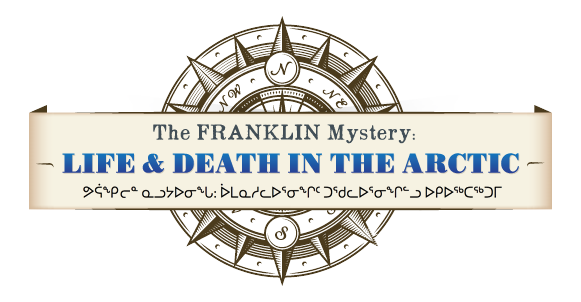Franklin Expedition Timeline
|
1818 - 1840 |
Britain sends a series of expeditions to the Canadian Arctic in search of the Northwest Passage, including two earlier expeditions led by Sir John Franklin. |
|
1845 |
Britain sends an Arctic expedition consisting of two ships and 129 men under the command of Franklin to search for the Northwest Passage and to carry out extensive geomagnetic observations in the Canadian Arctic. |
|
1845 - 1846 |
Franklin’s ships Erebus and Terror winter at Beechey Island off the southwest coast of Devon Island in Lancaster Sound after circumnavigating Cornwallis Island in the late navigation season of 1845. Three crew members died and are buried on Beechey Island. |
|
1846 |
Franklin directs his ships to the south where they sail through Peel Sound and become mired in the ocean pack ice in Victoria Strait off the northeastern shores of King William Island. |
|
1847 |
Sir John Franklin dies. |
|
1848 |
Expedition commanders Francis Crozier and James Fitzjames order the abandonment of the two vessels, which remained trapped in the ice of Victoria Strait, and lead the ships’ crews across the ice to re-establish themselves on the western shores of King William Island. By then, 24 men, including nine officers, had died. |
|
1847 - 1859 |
Britain and the United States send 20 search expeditions supported by 11 supply expeditions to look for Franklin’s missing party. |
|
1854 |
Dr. John Rae, travelling overland from Repulse Bay, Hudson Bay, reaches the vicinity of King William Island, where he obtains various artifacts from the Netsilingmiut and learns of the possible fate of Franklin’s men, including alleged cannibalism. |
|
1859 |
Captain Francis Leopold McClintock and Lieutenant William Hobson, travelling in separate sledge parties, find significant evidence of the fate of Franklin’s expedition, including the principal expedition record deposited in a cairn at Victory Point on King William Island. |
|
1869 |
The American journalist Charles Francis Hall, accompanied by a party of Netsilingmiut guides and his interpreters Ebierbing and Tookoolito of Baffin Island, travels from Repulse Bay to King William Island. The oral histories recorded by Hall over a five-year period form one of the most important collections of data on the fate of Franklin ever assembled, almost all of it Inuit testimony, and includes statements from some individuals who encountered the Franklin party directly. |
|
1878 - 1880 |
An American expedition led by Lieutenant Frederick Schwatka, accompanied by Netsilingmiut guides, travels overland from near Chesterfield Inlet, Hudson Bay to the area of King William Island and examines sites earlier visited by search parties and also new sites, establishing a much larger evidentiary base on the fate of Franklin’s expedition, including both artifacts and extensive Inuit testimony. |
|
1920 - 2013 |
Various explorers, mariners, and later, government agencies undertake a series of searches for further evidence of the fate of Franklin. |
|
1992 |
The remains of HMS Erebus and HMS Terror, still undiscovered, are declared a national historic site by the Government of Canada. |
|
2008 |
The Government of Canada led by Parks Canada launches a new search, using the latest underwater exploration technologies, for the missing ships, HMS Erebus and HMS Terror. |
|
2014 |
A team of searchers led by Parks Canada, other federal departments, the government of Nunavut, and private partners, discover the well-preserved wreck of HMS Erebus in 11 metres of water in Wilmot and Crampton Bay in the Queen Maud Gulf to the west the Adelaide Peninsula in Nunavut. |
|
2016 |
When an expedition led by Parks Canada continues searching in 2016, the Arctic Research Foundation team travelling on the research vessel Martin Bergmann discovers the well-preserved wreck of the HMS Terror near King William Island. |


